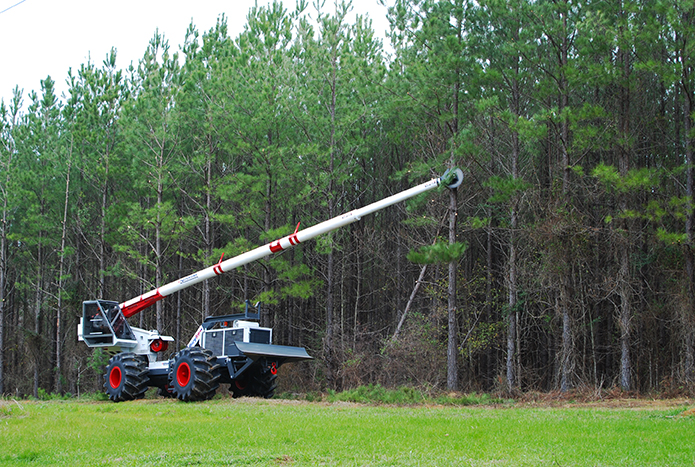Article provided in collaboration with Kershaw, a division of Progress Rail Services.
One of the more specialized products for the tree care industry is a 24-inch (61 cm) diameter, carbide-tipped tree-trimming saw with a turning speed of 2800 rpm.
- On the end of a 75-foot (22.9 m) telescoping boom constructed of fiberglass composite material electrically insulated for safety.
- Moved by a 24,000-pound (10,886.2 kg) rough terrain, rubber-tired vehicle powered by a 174-horsepower (129.8 kW) diesel engine.
- Operated by joystick controls from inside a cab that has a roof equipped with 1.25-inch-thick Lexgard® polycarbonate laminate for visibility and maximum protection.
- Able to work on all sides, as the boom and cab swing 360 degrees.

The equipment described is a SkyTrim 75 telescoping tree trimmer, manufactured by Kershaw, a division of Progress Rail Services. It’s used for clearing utility right-of-way areas and, for some tree-care contractors, it could provide a new business opportunity.
“The trend is for utilities to hire contractors for this type of work,” says Mike Balkom, national sales manager for Kershaw. “They want firm bids on the cost of clearing from point A to point B, which could be 250 miles (402.3 km) of distribution line or 50 miles (80.5 km) or more of transmission lines 100 feet (30.5 m) wide. Without a high production telescopic trimmer, it makes it difficult for contractors to compete when it comes to cross-country trimming.
In fact, he points out, you need this type of equipment to be considered by most utilities. That’s why some firms that are interested in entering the business start with a used machine and move up to new if successful.

“If you can accumulate a decent volume of work, the return on investment is very good,” says Balkom. “For example, a seven year-old used machine will range in price from $45,000 (needs some repairs) to $85,000 or more (checked out and ready to go). A new SkyTrim model sells for approximately $195,000 depending on options. So as these prices indicate, you need a substantial job or contract lined up to get started.”
Regardless of the brand of telescoping trimmer, the key to success is the operator, says Balkom. “The real skill is doing everything simultaneously. The ideal operator will have good hand-eye coordination and a vision of what the end result should look like. This type of operator will achieve maximum production and leave the right-of-way looking good.”
Production mileage with safety in mind is certainly important: There is a tremendous amount of power lines throughout the U.S. And, according to Balkom, tree limbs encroaching right-of-way areas need to be removed approximately every five (South) to seven (North) years.
That’s why he believes the industry outlook is good. “The power grid is expanding, with more poles and wires going up every week. The trend looks favorable well into the future.”
To learn about other tree care tools read Tools of the Trade: Chain Saws.
